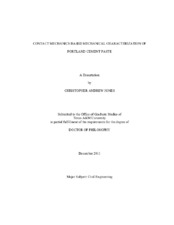| dc.contributor.advisor | Grasley, Zachary C. | |
| dc.creator | Jones, Christopher | |
| dc.date.accessioned | 2012-02-14T22:19:47Z | |
| dc.date.accessioned | 2012-02-16T16:16:20Z | |
| dc.date.available | 2014-01-15T07:05:34Z | |
| dc.date.created | 2011-12 | |
| dc.date.issued | 2012-02-14 | |
| dc.date.submitted | December 2011 | |
| dc.identifier.uri | https://hdl.handle.net/1969.1/ETD-TAMU-2011-12-10383 | |
| dc.description.abstract | Current research interest in multi-scale modeling of cement paste requires accurate characterization of the time-dependent mechanical properties of the material, particularly the C-S-H phase. Nanoindentation is evaluated as a tool for measuring both the instantaneous and the short-term viscoelastic properties of cement paste. Atomic force microscopy (AFM) based indentation is compared to conventional nanoindentaion in measuring mechanical properties of cement pastes. Time-dependent solutions are derived to characterize creep indentation tests performed on hardened cement paste and to extract the time-dependent properties. The effect of approximating C-S-H viscoelastic properties with a time-independent Poisson's ratio is discussed, and arguments for utilizing a time-independent Poisson's ratio for short-term response are presented. In evaluating AFM as a mechanical characterization tool, various analytical and numerical modeling approaches are compared. The disparities between the numerical self-consistent approach and analytical solutions are determined and reported.
The measured elastic Young's modulus values acquired by AFM indentation tests are compared to Young's modulus values from nanoindentation measurements from cement paste. These results show that the calcium silicate hydrate (C-S-H) phase of hydrated portland cement has different properties on the nanometric scale than on the micron scale. Packing density of C-S-H particles is proposed as an explanation for the disparity in the measured results. The AFM measured uniaxial viscoelastic compliance values are compared to similar values obtained with traditional nanoindentation for the same material. The comparison of these results shows that the calcium silicate hydrate (C-S-H) phase of portland cement has similar but distinct properties on the sub micron scale than on the micron scale. Additionally, the effect of moisture is evaluated by controlling the relative humidity (RH) of the testing environment between 40% and 100% plus, or wet. The viscoelastic compliance appears to be highest at 40% RH and the material appears to be less compliant at higher relative humidity levels. Possible mechanisms controlling the viscoelastic deformation are presented and evaluated in conjunction with the moisture related poromechanical effect. | en |
| dc.format.mimetype | application/pdf | |
| dc.language.iso | en_US | |
| dc.subject | contact mechanics | en |
| dc.subject | portland cement | en |
| dc.subject | concrete | en |
| dc.subject | nanoindentation | en |
| dc.subject | AFM | en |
| dc.title | Contact Mechanics Based Mechanical Characterization of Portland Cement Paste | en |
| dc.type | Thesis | en |
| thesis.degree.department | Civil Engineering | en |
| thesis.degree.discipline | Civil Engineering | en |
| thesis.degree.grantor | Texas A&M University | en |
| thesis.degree.name | Doctor of Philosophy | en |
| thesis.degree.level | Doctoral | en |
| dc.contributor.committeeMember | Lytton, Robert L. | |
| dc.contributor.committeeMember | Zollinger, Dan G. | |
| dc.contributor.committeeMember | Benzerga, Amine A. | |
| dc.type.genre | thesis | en |
| dc.type.material | text | en |
| local.embargo.terms | 2014-01-15 | |


